Math Topics
Learning Support
Professional
![]()


Test prep is always an issue requiring constant attention for teachers and students. Don't wait until the last minute to prepare. Standardized Test Preparation and Tips for Success includes two pages of resources:
 Target your test prep with CT4ME resources!
Target your test prep with CT4ME resources!
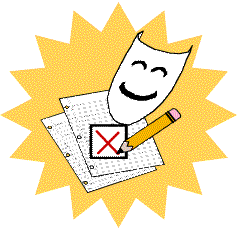 See CT4ME's Common Core
Resources for high school learners. Use these all year
long to address each of the domains within the Common Core math
standards.
See CT4ME's Common Core
Resources for high school learners. Use these all year
long to address each of the domains within the Common Core math
standards.
Our extensive collection of math resources for elementary, middle, and high school are also beneficial to help learners master concepts within state standards.
CT4ME developed a free Test-Prep KWL Chart for students to use to help them monitor their test preparation progress.
![]()
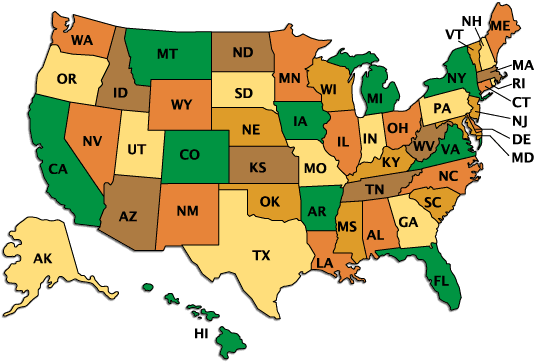 No
Child Left Behind legislation required states to measure students' progress in
reading and mathematics annually in Grades 3-8 and at least once in Grades 10-12
by 2005-2006.
No
Child Left Behind legislation required states to measure students' progress in
reading and mathematics annually in Grades 3-8 and at least once in Grades 10-12
by 2005-2006.
The Every Student Succeeds Act (ESSA) maintains the requirement that each state implement "a set of high quality student academic assessments in mathematics, reading or language arts, and science" (114th Congress, 2015, p. S. 177-24) among its provisions. Further, mathematics and reading or language arts assessments will be administered in each of grades 3 through 8, and at least once in grades 9 through 12 (p. S.1177-25).
Beginning in 2014-2015 school year, learners faced a new testing challenge in that their assessments of learning would be via online testing of the Common Core standards. Organizations such as PARCC and SBAC began developing assessments. Tests were predicted to take learners from 8-10 hours to complete (Doorey, 2014; Gewertz, 2013). As a result, educators became concerned about the nature of these tests and what appeared to be an excessive focus on test preparation. Online testing posed additional concerns about required technology, sufficient bandwidth, computerized test security, learners' technology skills, and new forms of test anxiety.
 Test
prep is a reality and there are steps you can follow to ensure success.
Test
prep is a reality and there are steps you can follow to ensure success.
![]() Computerized testing raises new issues that require updating of test security
laws and policies, as policies written for standardized testing administered via
paper-and-pencil are no longer sufficient. ACT has a highly relevant report in this regard:
The End of Erasures: Updating Test Security Laws and Policies for
Computerized Testing by Michelle Croft (2014).
Computerized testing raises new issues that require updating of test security
laws and policies, as policies written for standardized testing administered via
paper-and-pencil are no longer sufficient. ACT has a highly relevant report in this regard:
The End of Erasures: Updating Test Security Laws and Policies for
Computerized Testing by Michelle Croft (2014).
Croft (2014) outlined many concerns, noting that computerized testing does not eliminate cheating and test piracy. Such practices just take on different forms. Unique risks include such things as "educators logging in to tests to view questions or change student responses, computer hacking; keystroke logging; printing, emailing, or storing test information in a computer outside the test delivery system. ... there is a greater risk of students accessing the Internet and other programs during testing" (p. 1). There's concern about students using their own devices for testing and who has administrative privileges. How should workstations be positioned and secured so that students can't see what's on the monitors of others.
Croft (2014) recommended that states update their state statutes and regulations to reflect the shift to computer-administered assessments, concentrate efforts on controlling test access, and ensure that there is a single test security section within the updated manual that contains answers for any question that a test administrator has about test security. For example, policies should consider how student login information is secured. There should be rules on how tests are reactivated if disrupted:
The rules should emphasize having more than one proctor aid in the reactivation, and most importantly, proctors should maintain a log of all reactivations to provide documentation in the event of an investigation. Likewise, the technology should be secure and the testing window should be as short as possible to reduce the likelihood that items are compromised. Finally, states should actively monitor test access issues through data reports to determine if there have been excessive logins or logins at times when testing should not occur (e.g., on the weekends), and have clear policies in place detailing how violations will be handled. (p. 4)
The test security section should also include an itemized list of what materials are secure (e.g., work folders, student authorization tickets with IDs and passwords, session rosters, scratch paper, reference sheets). "Information about who can access the test should be clearly articulated. In addition, there should be information on how to report test security concerns and possible violations, which can be applicable regardless of the testing format" (Croft, 2014, p. 4).
Thus, educators should become familiar with any new policies regarding computerized test administration, including what they, test proctors, and students may and may-not do.
![]() Good instruction is the best test preparation! So how does one plan for
good instruction? In A Case Study of Key Effective
Practices in Ohio's Improved School Districts,
Research Associates Aaron Kercheval and Sharon Newbill (2002) reported the key
effective test preparation strategies included:
Good instruction is the best test preparation! So how does one plan for
good instruction? In A Case Study of Key Effective
Practices in Ohio's Improved School Districts,
Research Associates Aaron Kercheval and Sharon Newbill (2002) reported the key
effective test preparation strategies included:
According to Douglas Reeves (2004), "Even if the state test is dominated by lower-level thinking skills and questions are posed in a multiple choice format, the best preparation for such tests is not mindless testing drills, but extensive student writing, accompanied by thinking, analysis, and reasoning" (p. 92).
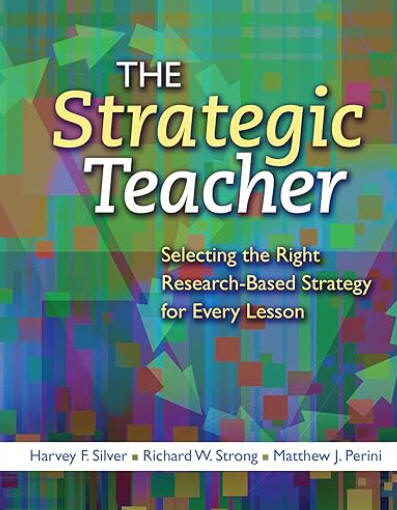 Silver, Strong, and Perini,
authors of The strategic teacher:
Selecting the right research-based strategy for every lesson (2007), found that student success on
standardized tests, regardless of grade level or content area, hinges on 12 core
skills relating to those ideas. They grouped those skills into four
categories in what they call "Hidden Skills of Academic Literacy." They
said, "If we expect students to perform well on state tests, we must teach them
how to apply these skills without cutting into content." Unfortunately, the
skills that follow have been "radically undertaught and rarely benchmarked"
(Part One: Introduction section):
Silver, Strong, and Perini,
authors of The strategic teacher:
Selecting the right research-based strategy for every lesson (2007), found that student success on
standardized tests, regardless of grade level or content area, hinges on 12 core
skills relating to those ideas. They grouped those skills into four
categories in what they call "Hidden Skills of Academic Literacy." They
said, "If we expect students to perform well on state tests, we must teach them
how to apply these skills without cutting into content." Unfortunately, the
skills that follow have been "radically undertaught and rarely benchmarked"
(Part One: Introduction section):
For many teachers, instruction has come to mean addressing as many standards as possible. A standard is the goal that we wish students to attain and the benchmark is the assessment used to test a student's progress toward reaching the goal. It identifies the student's strengths and weaknesses and is then used to inform future instruction. However, state exams do not test every benchmark annually.
Benchmarking tests could be given periodically, perhaps every nine weeks, to monitor progress in mastering standards and objectives. Such tests might be developed by districts. However, the best test-prep will include that teachers integrate the kinds of questions that learners will encounter into their every day lessons.
A diagnostic tool, or a formative assessment tool (screening, progress, and diagnostic) will help educators identify specific areas of weakness that students might have, and will also help educators to tailor their classroom instruction to meet the needs of students. It can also be used before planning a unit of instruction. The Northwest Evaluation Association's Measures of Academic Progress is a possible tool. These are Common Core-aligned assessments that provide information about student achievement and growth.
Although a diagnostic test with item analyses reveals weaknesses in concepts and content related to strands tested, teachers will still need to delve deeper into an analysis of why students missed certain questions. At a second level, student literacy skills might have played a role in not answering a question correctly.
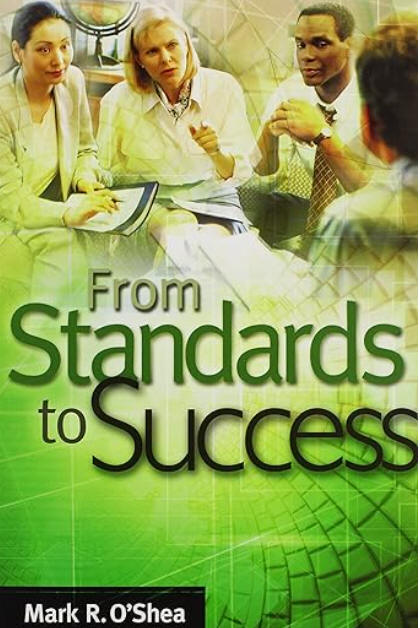 To assist teachers with providing good instruction leading to improved student outcomes, Mark O'Shea
(2005), author of From Standards to Success, suggested that teachers have copies of standards and frameworks for each
subject they teach, and use them along with related state documents to plan
lessons in regularly scheduled grade-level or subject matter team meetings. Instruction
should not include "unchallenging student desk work, including
word searches, sentence completion exercises, puzzles, and other forms of
response sheets not linked to standards" (p. 13). In addition to
identifying a topic and rationale, a truly standards based lesson would include:
To assist teachers with providing good instruction leading to improved student outcomes, Mark O'Shea
(2005), author of From Standards to Success, suggested that teachers have copies of standards and frameworks for each
subject they teach, and use them along with related state documents to plan
lessons in regularly scheduled grade-level or subject matter team meetings. Instruction
should not include "unchallenging student desk work, including
word searches, sentence completion exercises, puzzles, and other forms of
response sheets not linked to standards" (p. 13). In addition to
identifying a topic and rationale, a truly standards based lesson would include:
Further, O'Shea (2005) indicated that districts should:
Joan Herman and Eva Baker (2005) said that there should be a strong predictive relationship between students' performance on benchmark tests and their performance on state assessments. They cautioned, however, that aligning benchmark tests too closely with a state's tests may accelerate curriculum narrowing. Tests should "focus on the big ideas of a content area" and be designed to "allow students to apply their knowledge and skills in a variety of contexts and formats" (p. 49). For mathematics test items, this might include giving short answers, using multiple choice with extended explanations for why an option was selected, and drawing pictures to demonstrate a concept. In Making Benchmark Testing Work, they provided the following six criteria to help educators make benchmark testing effective:
Inspite of having a math textbook, students don't necessarily read it and depend on their teachers to provide all the "how-to's." In keeping with Silver, Strong, and Perini (2007), students need reading and study skills. Consider providing students with tips for How to Learn from a Math Book, suggested by Cynthia Arem and Paul Nolting:
How-to-study.com also has tips for reading a math textbook.
In order to "make sense of abstract academic vocabulary" per Silver, Strong, and Perini (2007) and do well on standardized tests, students need to know and understand what those key vocabulary terms are. You might ask students to note specialized math terminology used within questions posed when solving problems and ask them to define these in their own words. You might be amazed at how many students have difficulty with the key action words and math vocabulary.
 If students do not know the meaning of
words within test items, they cannot complete the problems successfully.
In The essential 25: Teaching the vocabulary that
makes or breaks student understanding Marilee Sprenger (2021)
shared her "list of 25 essential high-frequency words that are used in
standardized assessments and other academic contexts across states and grade
levels." They Include: "analyze, cite, compare, contrast, demonstrate,
describe, details, determine, develop, distinguish, evaluate, evidence, explain,
infer, interpret, main idea, paraphrase, persuade, point of view, relevant,
structure, summarize, support, theme, and trace" (Introduction section).
Such words are not typical of everyday speech. Encourage students to
use correct mathematical vocabulary in discussion and in their writing.
If students do not know the meaning of
words within test items, they cannot complete the problems successfully.
In The essential 25: Teaching the vocabulary that
makes or breaks student understanding Marilee Sprenger (2021)
shared her "list of 25 essential high-frequency words that are used in
standardized assessments and other academic contexts across states and grade
levels." They Include: "analyze, cite, compare, contrast, demonstrate,
describe, details, determine, develop, distinguish, evaluate, evidence, explain,
infer, interpret, main idea, paraphrase, persuade, point of view, relevant,
structure, summarize, support, theme, and trace" (Introduction section).
Such words are not typical of everyday speech. Encourage students to
use correct mathematical vocabulary in discussion and in their writing.
Quick definitions of those high-frequency terms:
Vocabulary.com has a series of test prep vocabulary lists for a variety of standardized tests with definitions of the terms. The lists of Essential Math Vocabulary and The Language of Standardized Tests are of particular value.
Emphasize that often there is more than one way to solve a problem. Provide students with problems that use those strategies, which generally fall into the following categories:
| Problem Solving Strategies | ||
| Compute or simplify | Use a formula | Make a model |
| Make a table, list, or chart | Guess, check, and revise | Determine if problem requires a single-step or multiple-steps to solve |
| Solve a simpler case or work backwards | Look for a pattern | Write an equation |
| Eliminate possible solutions and/or extra information | Draw a picture or diagram | Use logical reasoning |
As Reeves recommended, extensive writing is the best preparation for state tests (2004). Writing helps students to make sense of mathematics and helps them to identify what they know or don't know. As students tackle problems, stress George Polya's (author of "How to Solve It") problem solving steps: The four steps are:
Visual students might then appreciate the How to Solve It Mind Map posted at GoGeometry.com. It is interactive illustrating Polya's steps with key questions to consider at each stage in problem solving.
Select resources related to any weaknesses students have demonstrated on benchmark and formative testing. CT4ME has numerous resources related to each strand in the Common Core math standards for high school learners to help in your selection. For each, you will find technology-enhanced investigations, multiple choice and constructed response questions, and performance tasks.
When students feel confident that they have mastered objectives, they should complete a few practice tests and released test items from your state. Practice tests should be scored using the same rubric as will be used on the actual test. CT4ME has links to K-12 testing in each state and additional resources with other tips and test prep materials.
As noted in Kercheval and Newbill (2002), effective test preparation included direct instruction in test-taking skills. As such, students should know the testing format, test instructions, and procedures they will follow on test day. They should know how test items will be scored. Review techniques for completing multiple choice, short-answer and extended response questions, as the math exam will contain these three types. Learners need to know about the mechanics of test taking, such as distracters, adhering to time limits, working with bubble sheets or online testing formats, reading and following test directions, and using deductive thinking to eliminate incorrect answers.
For multiple choice questions, remind learners to read the entire question before attempting to answer it, try to answer the question without looking at the choices first, and not to keep changing an answer because usually learners' first choice is the right one, unless they did not read the question correctly. Beyond reading directions carefully, tips for short-answer and extended response questions include to not give personal opinion when the question asks for facts, reread the response after completing it to ensure it addresses all parts of the question and is accurate. Learners should focus on one main idea per paragraph. If there is time remaining, proofread work and correct any errors. To accurately answer short-answer and extended response questions, students also should know the meaning of specific performance verbs, such as those presented in Sprenger (2021) (e.g., analyze, compare, describe, evaluate, explain, formulate, infer, predict, summarize, support, trace).
As learners prepare for the actual test, they might have some test anxiety. How-to-study.com has a short assessment to determine whether you have test anxiety and what to do about it. Cuesta College provides relaxation techniques and how to overcome negative self-talk in How to Reduce Test Anxiety. You'll also find other test taking and study strategies for math. There's more on math anxiety below.

![]() What has changed for Common Core assessments, however, in relation to that good instruction
is that teachers need to ensure their learners also have the technology skills to
perform well on tests administered online. Per Kristine Gullen (2014), "If
we want an online assessment to capture a student's level of learning,
rather than that student's ability to navigate technology, teachers must
integrate these skills into their instruction, giving students practice
before administering high-stakes exams on a computer" (p. 69). Hence,
among the best ways to prepare learners for new assessments is to integrate test
preparation into every day lessons using CCSS-type questions linked to the
curriculum and to use technology for assessments and as a content learning tool.
It's more effective than a two-week or more crash effort for test prep prior to
the actual high-stakes exam (Miller, 2014).
What has changed for Common Core assessments, however, in relation to that good instruction
is that teachers need to ensure their learners also have the technology skills to
perform well on tests administered online. Per Kristine Gullen (2014), "If
we want an online assessment to capture a student's level of learning,
rather than that student's ability to navigate technology, teachers must
integrate these skills into their instruction, giving students practice
before administering high-stakes exams on a computer" (p. 69). Hence,
among the best ways to prepare learners for new assessments is to integrate test
preparation into every day lessons using CCSS-type questions linked to the
curriculum and to use technology for assessments and as a content learning tool.
It's more effective than a two-week or more crash effort for test prep prior to
the actual high-stakes exam (Miller, 2014).
Learners need practice with the new testing formats, and new types of questions. For example, multiple choice questions might have more than one answer. They need practice with the same and must be able to enter test responses via a keyboard, sometimes placing those in boxes on the screen. Fluid keyboarding skills will help minimize frustration when answering constructed-response questions. They also need good "mousing" or "touchscreen" skills to enter or remove responses via click or drag and drop into particular places on a screen. And they need to build endurance for working long periods of time at the computer via gradual focused exposure to the new testing scenario.
Gullen (2014) noted that learners also need skills highlighting text, drawing lines and creating graphs on a screen, operating an online calculator, and using a scroll bar. The need to use a scroll bar might be increased if learners also need to increase font size, an accommodation feature. Above all learners need "opportunities to build a level of comfort with the actual keyboards, screens, eternal mouse or touch pads, and so on that they'll use during the assessment" (p. 71). Piloting online assessments from PARCC or SBAC or your state will help in this endeavor, as will debriefing learners following those about their difficulties and recommendations for additional skills they need to develop.
Teachers also need to be aware of online testing accommodations that might be needed for special needs learners. Such learners should not be expected to take a standardized test online without having adequate experience with identified accommodations they will need. For example, visually impaired learners might need text-to-speech readers, particularly if they have typically had human readers. Some might need a zoom feature to enlarge text. This feature to magnify might be embedded in the test for all learners. Those with motor impairments might need a scribe, or an assistive technology or special equipment such as a recording device to enter responses. English language learners might need a translation for certain words; however, teachers should check the testing rules regarding the use of electronic word-for-word dictionaries (e.g., computer-based, web-based, or hand-held) for online standardized testing.
![]()
![]() We would hope that teachers use a broad range of curricular materials and
activities that address standards--what we have identified as important for
students to know and be able to do. Teaching to the test is not a new
practice brought about by NCLB or ESSA, nor will it be any different for preparing
learners for testing of the Common Core standards or your state standards. Teachers have been doing it for as long as
standardized tests have been used to make important educational decisions.
We would hope that teachers use a broad range of curricular materials and
activities that address standards--what we have identified as important for
students to know and be able to do. Teaching to the test is not a new
practice brought about by NCLB or ESSA, nor will it be any different for preparing
learners for testing of the Common Core standards or your state standards. Teachers have been doing it for as long as
standardized tests have been used to make important educational decisions.
Years ago, William Mehrens (1989) stated, "Although teaching to the test is not a new concern, today's greater emphasis on teacher accountability can make this practice more likely to occur. Depending on how it is done, teaching to the test can be either productive or counterproductive" (para. 2, 3). Those words are still true. He and his colleague Kaminski (1989, cited in Mehrens, 1989) suggested the following seven points on the continuum along which practices range from ethical to unethical, or legitimate to illegitimate.
Ethical:
Typically Ethical:
Cross-over point depends on inferences you wish to draw from the test and lies between:
Mehrens (1989) indicated, "The inferences you typically wish to draw from test scores are general in nature and will be inaccurate if you limit instruction to the actual objectives sampled in the test or, worse yet, to the actual questions on the test" (Summary section).
Unethical:
Educators will observe, however, that current test prep efforts do include using questions from old tests, which state departments of education release. Technically, these are not parallel forms of the same test.
Many are concerned that standards-based instruction neglects the diverse learning needs of students. However, Carol Ann Tomlinson (2000) indicated, "There is no contradiction between effective standards-based instruction and differentiation" (i.e., attending to the diverse needs of learners). "Curriculum tells us what to teach: Differentiation tells us how." For any standard, "Differentiation suggests that you can challenge all learners by providing materials and tasks on the standard at varied levels of difficulty, with varying degrees of scaffolding, through multiple instructional groups, and with time variations. Further, differentiation suggests that teachers can craft lessons in ways that tap into multiple student interests to promote heightened learner interest in the standard. Teachers can encourage student success by varying ways in which students work: alone or collaboratively, in auditory or visual modes, or through practical or creative means" (p. 9).
Ultimately, students should have clear knowledge of which benchmarks they have not yet mastered. Consider posting standards and benchmarks for mastery in your classroom and providing each student with a copy from which they can monitor their progress. However, keep in mind that posting standards and benchmarks in your classroom and just reading them does not mean that students understand what mastery means. For them to take responsibility, they must be able to self-assess and self-adjust their learning from standards that are broken down into meaningful components. A good way to do this would be to provide students with K-W-L charts to help them keep track of the standard and benchmark, the resource(s) they used to address it, what they know, would like to know, and what they learned from the resource they used. CT4ME developed a free Test-Prep KWL Chart for this purpose.
Teaching to the Test?--An Answer to Consider
Jeff Weinstock (2008) of THE Journal provided food for thought for critics of standardized testing. "When the system works the way it should, teaching to the test is a misnomer. It's not the test that teachers are teaching to, but the state learning standards embedded in the test. Has the student learned this, that, and the other?...Count me among those who think introducing some accountability into math instruction is an idea whose time has come. I can't suffer another generation of supermarket cashiers who become disoriented when I hand over $8.07 for a $7.82 bill" (p. 8).
Read Dr. Patricia Deubel's commentary, Accountability, Yes. Teaching to the Test, No featured April 10, 2008, in THE Journal.
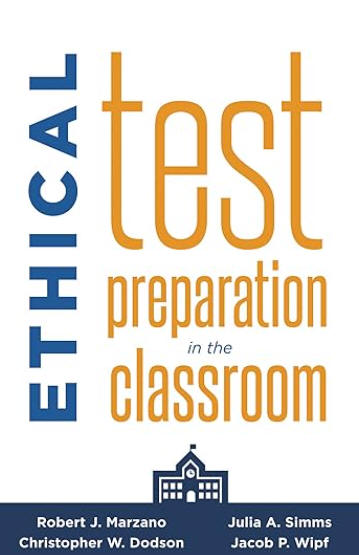 Robert Marzano, Christopher Dodson, Julia Simms, and Jacob Wipf
(2021) address this topic in their book:
Ethical Test Preparation in the
Classroom (Prepare Students for Large-Scale Standardized Tests with
Ethical Assessment and Instruction). There are six
chapters. They present the impact of such tests on students'
lives, and an analysis of English Language Arts, Math, and Science test
items for all to understand how such items are constructed and to
provide recommendations for creating items. The last chapters
delve into the issue of test preparation and a systematic approach
to ethical ways for doing so.
Robert Marzano, Christopher Dodson, Julia Simms, and Jacob Wipf
(2021) address this topic in their book:
Ethical Test Preparation in the
Classroom (Prepare Students for Large-Scale Standardized Tests with
Ethical Assessment and Instruction). There are six
chapters. They present the impact of such tests on students'
lives, and an analysis of English Language Arts, Math, and Science test
items for all to understand how such items are constructed and to
provide recommendations for creating items. The last chapters
delve into the issue of test preparation and a systematic approach
to ethical ways for doing so.
Test Prep and Math Realities
Read Dr. Patricia Deubel's commentary, "Test Prep and Math Realities," featured September 27, 2007, in THE Journal.
![]() A major survey study conducted by Williams, Kirst, Haertel, et al. (2010) in the
2008-2009 school year in 303 California middle schools echoes many of
the recommendations noted above. The study
illustrated a culture change that must take place within districts to
focus on student outcomes and illustrated that test preparation and
standards-based instruction are not solely the role of individual
teachers. Student responsibility and parent involvement are key, as are
the roles of district, state, and federal leadership. Although the study yielded practices that have a potential to
positively affect achievement on standardized tests in math and English
language arts (ELA) at the middle school level, the major findings are worthy
of consideration for implementation at all K-12 levels for ELA and math. Readers are cautioned that this
was correlational research, not experimental research. Hence, cause and
effect conclusions between practices and outcomes cannot be drawn.
Illustrative major findings in the Narrative Summary include:
A major survey study conducted by Williams, Kirst, Haertel, et al. (2010) in the
2008-2009 school year in 303 California middle schools echoes many of
the recommendations noted above. The study
illustrated a culture change that must take place within districts to
focus on student outcomes and illustrated that test preparation and
standards-based instruction are not solely the role of individual
teachers. Student responsibility and parent involvement are key, as are
the roles of district, state, and federal leadership. Although the study yielded practices that have a potential to
positively affect achievement on standardized tests in math and English
language arts (ELA) at the middle school level, the major findings are worthy
of consideration for implementation at all K-12 levels for ELA and math. Readers are cautioned that this
was correlational research, not experimental research. Hence, cause and
effect conclusions between practices and outcomes cannot be drawn.
Illustrative major findings in the Narrative Summary include:
You can read a more complete review of this study at our Education Research page for Standards, Raising Achievement, Assessment, and How People Learn.
![]() Much
has been written about the role of math anxiety and how it affects a
student's performance in mathematics. Fortunately, there are
instructional strategies that teachers can use to help minimize it
and strategies that students can use, which you will find in the next
section devoted to it.
Much
has been written about the role of math anxiety and how it affects a
student's performance in mathematics. Fortunately, there are
instructional strategies that teachers can use to help minimize it
and strategies that students can use, which you will find in the next
section devoted to it.
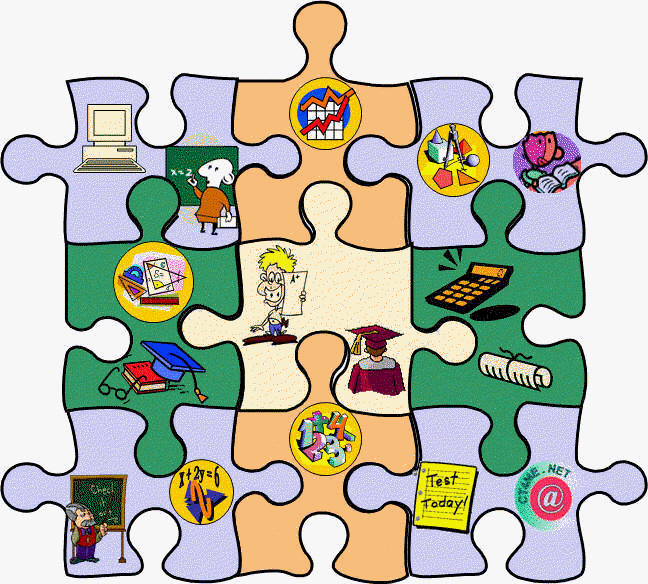 Finally,
the above strategies should lead to TEST SUCCESS! But,
after all this preparation, remind students to get a good rest the night
before and to eat a good breakfast on test day. These strategies have
given them the confidence they need to do well.
Finally,
the above strategies should lead to TEST SUCCESS! But,
after all this preparation, remind students to get a good rest the night
before and to eat a good breakfast on test day. These strategies have
given them the confidence they need to do well.
According to the National Mathematics Advisory Panel (2008) in its Foundations for Success:

"Anxiety about mathematics performance is related to low mathematics grades, failure to enroll in advanced mathematics courses, and poor scores on standardized tests of mathematics achievement. It also may be related to failure to graduate from high school. At present, however, little is known about its onset or the factors responsible for it. Potential risk factors for mathematics anxiety include low mathematics aptitude, low working memory capacity, vulnerability to public embarrassment, and negative teacher and parent attitudes." (p. 31)
Most likely, everyone has experienced math anxiety at one time or another. It is an emotional response that often comes from negative experiences working with teachers, tutors, classmates, or family members. Symptoms include panic (feeling helpless about an ability to do better and putting pressure on yourself, which affects your ability to concentrate), paranoia (feeling that everyone but you knows the answer), passivity (feeling that regardless of what action you might take, you were just not born with math ability; hence you do nothing to overcome the problem), no confidence (you continually question yourself and approach math by memorizing rules and procedures, rather than through understanding concepts). Identifying the source of your problem may be a first step in overcoming it.
Do you have math anxiety?
 Take a self-test
from Dr. Ellen Freeman of Mathpower.com.
Take a self-test
from Dr. Ellen Freeman of Mathpower.com.
How-to-study.com also has a short assessment to determine whether you have test anxiety and what to do about it.
Does math anxiety lead to poor performance or does poor math performance lead to math anxiety? Research is mixed as to which comes first, the emotion or poor performance. Carey, Hill, Devine, and Szücs (2016) discussed theories:
Student performance on math exams can to be affected by the strategies they use to prepare for exams and the time they spend on those. In their study of math exam preparation and math anxiety, Jenifer, Rosek, Levine, and Beilock (2022) included the following test prep strategies: "reading textbook section(s) for the first time, rereading textbook section(s), reviewing homework solutions, solving practice problems, reading examples of solved problems, and reviewing notes" (p. 3). They found that problem-solving was the most effortful study strategy and that "math anxiety was associated with less planned engagement with effortful problem-solving during studying. Moreover, the avoidance of effortful problem-solving engagement partially mediated the association between math anxiety and exam performance, marking it as a potential target for intervention" (p. 1).
Jenifer, Rosek, Levine, and Beilock (2022) found that "math-anxious students avoid engaging with effortful study strategies, specifically solving practice problems, when preparing for a math exam" (p. 4). When solving problems, "math-anxious students were less likely to prioritize harder practice problems compared to their less anxious peers" (p. 4). Further, "math anxiety was related to how effortful students perceived particular study strategies to be, with greater anxiety being associated with ranking solving practice problems as more effortful and with ranking rereading the textbook as less effortful. These findings seem to suggest that math-anxious students’ avoidance of effortful study strategies may be caused by biased perceptions of the amount of effort required for certain study behaviors" (p. 6).
In addition to outward behavior manifestations of math anxiety, there is biological evidence of its existence. According to Dr. Venod Menon of the Stanford University School of Medicine, "Math anxiety is an under-studied phenomenon, which still lacks formally established diagnostic criteria ... it is possible for someone to be good at math, but still suffer from math anxiety" (Digitale, 2012, para. 9). Menon and his team of researchers used brain scans in their study of 46 second- and third-grade students with low and high math anxiety, and found that "Children with high math anxiety were less accurate and significantly slower at solving math problems than children with low math anxiety. The results suggest[ed] that, in math anxiety, math-specific fear interferes with the brain’s information-processing capacity and its ability to reason through a math problem" (para. 16-17). "His team’s observations show[ed] that math anxiety is neurobiologically similar to other kinds of anxiety or phobias" (para. 11). Results may lead to new strategies for treatment of it, as in ways suggested for treatment of other anxieties and phobias.
Findings from research are particularly relevant for pedagogical methods that have been successful with learners, particularly in terms of reducing math anxiety. However, the potential for a bidirectional relationship between math anxiety and math performance per Carey et al. (2016, Reciprocal Theory section) would suggest that any interventions should address both math anxiety and math performance.
Blazer (2011) reviewed strategies that teachers can use to help reduce students' anxiety, thus leading to better achievement for all:
Researchers at Stanford University School of Medicine (2015) found that one-on-one tutoring can be used to relieve math anxiety. Grade 3 learners with high math anxiety participated in the study. The tutoring "fixed abnormal responses in the brain's fear circuits," as noted by functional MRI brain scans.
Educators must take math anxiety seriously. One way to potentially help learners reduce the negative affects of their math anxiety is writing about it prior to taking a math test, as suggested in Neuroscience and Education: A Review of Educational Interventions and Approaches Informed by Neuroscience (Howard-Jones, 2014) commissioned by the Education Endowment Foundation in London. Howard-Jones noted:
"An intervention focused on controlling negative emotional response has reported improved achievement. Writing about anxieties may be one way to rehearse such control. Following on from laboratory-based studies, a school-based intervention was carried out among students aged 14-15 years (N=106). These students first rated their own anxiety and were then randomly allocated into two groups. For 10 minutes, immediately before a maths test, one group wrote about mathematics-related anxieties and the other about a topic not in the test. Amongst students who had had rated themselves as more anxious, those who wrote about their anxieties significantly outperformed maths anxious students in the other group, performing similarly to less maths anxious students." (p. 16)
This aforementioned study was conducted by Gerardo Ramirez and Sian L. Beilock in 2011. Read the details in Writing About Testing Worries Boosts Exam Performance in the Classroom.
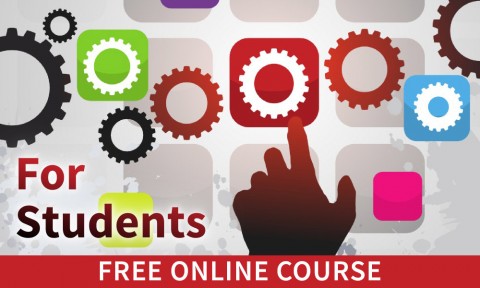 Another
potential strategy to minimize anxiety is for students to learn how to
learn math. Dr. Jo Boaler of Stanford University has a short, free course at
youcubed.org called "How
to Learn Math" for any student in all levels of mathematics.
There are six short lessons about 10 to 20 minutes each. You'll
get some key information on the brain and learning, and effective
strategies for learning math. Concepts include overcoming myths
about math, math and mindset, mistakes and speed; number flexibility,
math reasoning, and connections; number patterns and representations;
and math in life, nature, and work. The course also features
videos of math in action.
Another
potential strategy to minimize anxiety is for students to learn how to
learn math. Dr. Jo Boaler of Stanford University has a short, free course at
youcubed.org called "How
to Learn Math" for any student in all levels of mathematics.
There are six short lessons about 10 to 20 minutes each. You'll
get some key information on the brain and learning, and effective
strategies for learning math. Concepts include overcoming myths
about math, math and mindset, mistakes and speed; number flexibility,
math reasoning, and connections; number patterns and representations;
and math in life, nature, and work. The course also features
videos of math in action.
Additional Resources
 Learn more about what math anxiety is, how to take possession of your
math anxiety, and get some strategies for how to study math and take tests.
Learn more about what math anxiety is, how to take possession of your
math anxiety, and get some strategies for how to study math and take tests.
How-to-study.com provides a short math study skills assessment, followed by tips for improving skills. Also see tips for math test preparation.
Read Coping with Math Anxiety at Platonic Realms.
Deconstructing Maths Anxiety: Helping Students to Develop a Positive Attitude Towards Learning Maths by Dr. Sarah Buckley (2013) of the Australian Council for Educational Research.
Cuesta College provides short and long term relaxation techniques and how to overcome negative self-talk in How to Reduce Text Anxiety, referencing Winning at Math, a 1997 work by Paul D. Nolting, Ph.D. You'll also find other test taking and study strategies for math.
HOT! Strategies for Reducing Math Anxiety, Volume 1102, September 2011, is an Information Capsule from the Research Services of Miami-Dade County Public Schools. It contains specific strategies for teachers, parents, and students to use to reduce math anxiety.
In Math Anxiety: A Factor in Math Achievement Not to Be Ignored, Sian Beilock and Erin Maloney (2015) highlight "the most recent findings from research in psychology, education, and neuroscience on math anxiety. [They] then discuss the consequences of math anxiety as well as likely causes and promising remediations." The authors also suggest that "initiatives currently underway to improve STEM involvement and achievement would benefit from educating current and future teachers, parents, and even students about math anxiety, its causes, consequences, and possibilities for amelioration." (Abstract section)
In Math Anxiety: What Have We Learned in 60 Years, Ann Dowker, Amar Sarkar, and Chung Yen Looi (2016) "discuss what mathematics anxiety is; how distinct it is from other forms of anxiety; and how it relates to attitudes to mathematics. [They] discuss the relationships between mathematics anxiety and mathematics performance. [They] describe ways in which mathematics anxiety is measured, both by questionnaires, and by physiological measures. [They] discuss some possible factors in mathematics anxiety, including genetics, gender, age, and culture. Finally, [they] describe some research on treatment" (para. 1).
In
Research Suggests Timed Tests Cause Math Anxiety, Jo Boaler
(2014) "summarize[d] the evidence from neuroscience and describe[d]
an alternative pedagogical routine that teaches number sense and
math fluency at the same time as it encourages mathematical
understanding and excitement" (p. 469). That routine involves
number talks, which work well with students of different achievement
levels. This article was published in NCTM's Teaching
Children Mathematics, (20)8, 469-474.
Caution:
Readers should be aware of a misconception about timed tests. Citing
the research, the Advocates for the
Science of Math (2021) stated:
"No
studies have determined that timed tests cause math anxiety - defined as
feelings of apprehension, tension, or fear that may interfere with
performance on math-related tasks. ... In fact, timed tactics improve math
performance." They list ways that timed tests and activities are
helpful.
YouTube has a series of self-help videos on math anxiety on how to reduce it.
Furner, J. M. (2016). Every student can be an Einstein: Addressing math anxiety in today's classrooms. Transformations, 2(2), article 3. https://nsuworks.nova.edu/transformations/vol2/iss2/3/
Ramirez, G., Shaw, S. T., & Maloney, E. A. (2018). Math anxiety: Past research, promising interventions, and a new interpretation framework. Educational Psychologist, 53(3), 145–164. https://www.researchgate.net/publication/324468493_Math_Anxiety_Past_Research_Promising_Interventions_and_a_New_Interpretation_Framework The authors presented "an overview of past research [from psychology, education and neuroscience] that has investigated the association between math anxiety and math achievement, factors that can cause math anxiety, characteristics of students that can increase their susceptibility to math anxiety, and efforts that educators can take to remedy math anxiety" They also proposed "a new Interpretation Account of how math anxiety develops" (p. 145).
Yu, Y., Hua, L., Feng, X., Wang, Y., Yu, Z., Zi, T., Zhao, Y., & Li, J. (2021). True grit in learning math: The math anxiety-achievement link is mediated by the math-specific grit. Frontiers in Psychology. https://www.frontiersin.org/articles/10.3389/fpsyg.2021.645793/full The authors defined math-specific grit as "sustaining effort in the face of adversity in learning math." They stated that this study provided "the first evidence that math-specific grit may mediate the relationship between math anxiety and math achievement."
 Tutoring
can be provided in a variety of ways, including in both face-to-face and online
settings. The National Center for Education Statistics (2022) provided
definitions of three types of tutoring:
Tutoring
can be provided in a variety of ways, including in both face-to-face and online
settings. The National Center for Education Statistics (2022) provided
definitions of three types of tutoring:
Pellegrini, Lake, Inns, and Slavin (2018) noted programs have been used in one-to-one tutoring by teachers, paraprofessionals, and paid volunteers; one to small-group tutoring by teachers and small group tutoring by paraprofessionals. For example, the Stanford University Medical Center (2015) found that "Anxiety about doing math problems can be relieved with a one-on-one math tutoring program. ... The tutoring fixed abnormal responses in the brain's fear circuits."
Although most would agree that tutoring is a valuable service for learners who need it, Robert Slavin (2018) pointed out four shockers in recent findings on tutoring gleaned from three studies. "One is a review of research on programs for struggling readers in elementary schools by Amanda Inns and colleagues (2018). Another is a review on programs for secondary readers by Ariane Baye and her colleagues (2017). Finally, there is a review on elementary math programs by Marta Pellegrini et al. (2018)." The four shockers that follow challenge common beliefs about tutoring and have implications for tutoring programs. As Slavin stated:
In all three reviews, tutoring by paraprofessionals (teaching assistants) was at least as effective as tutoring by teachers.
Volunteer tutoring was far less effective than tutoring by either paras or teachers.
Inexpensive substitutes for tutoring have not worked.
Certain whole-class and whole-school approaches work as well or better for struggling readers than tutoring, on average.
Slavin's (2018) theory to account for the positive effects of tutoring in light of the four “shockers” is this:
"Tutoring does not work due to individualization alone. It works due to individualization plus nurturing and attention."
Just as in the classroom, tutors need to be qualified and have subject-matter expertise. Although certification and prior teaching experience are valued, Slavin (2020) noted that "teaching assistants, with proven materials and expert professional development, can obtain outcomes as good as those obtained by certified teachers working as tutors" (para. 9).
A tutor needs to know if the student has a learning disability, and if so, the tutor should have skills in working with the specific disability. If not, then the tutor and/or program might not be appropriate for that student. Edward Gordon (2006) provided the following suggestions on what to look for in a good tutoring program.
In his commentary on Designing an Effective System of Services for Struggling Students, Slavin (2021) stated:
"There are two policies that are needed to provide a system of services capable of substantially improving student achievement. One is to provide services during the ordinary school day and year, not in an after school or summer school. The second is to strongly emphasize the use of programs proven to be highly effective in rigorous research."
Among rationals for providing tutoring during a school day is that there is an increase likelihood that students will attend those sessions, as they are expected to be in school, as opposed to sessions during non-school time. Services during the school day (e.g., tutoring) are easier to integrate with other educational services and "entail far fewer non-educational costs" (Slavin, 2021). Further, Barshay (2021) noted:
"Education researchers have a particular kind of tutoring in mind, what they call “high-dosage” tutoring. Studies show it has produced big achievement gains for students when the tutoring occurs every day or almost every day" (Tutoring section).
"High-dosage" tutoring is also called "high-impact" tutoring. The National Student Support Accelerator (n.d.) program of the Annenberg Institute at Brown University is devoted to providing comprehensive resources for those who are interested in implementing high-impact tutoring. "Research shows that high-impact tutoring — tutoring delivered three or more times a week by consistent, trained tutors using quality materials and data to inform instruction — is one of the most effective academic interventions, providing an average of more than four months of additional learning in elementary literacy and almost 10 months in high school math" (About: What is the Accelerator? section).
Cautions:
Matthew Kraft of Brown University (cited in Ofgang, 2022) provided a caution regarding use of companies that claim to offer high-dosage online tutoring: "Make sure terminology around online tutoring is defined." He noted that "high-quality, high-dosage tutoring programs tend to include the following characteristics:
In her Hechinger report, Jill Barshay (2023) cautioned that schools should be wary of buying online drop-in tutoring, as "the research doesn't support it." Per the headline, "Obstacles to success include low uptake, a rotating cast of tutors and no link to students' learning gaps." Barshay referred to 2022 and 2023 research in her commentary from which I gleaned the following. School leaders should be wary of any claims regarding student outcomes for using the product from any research posted as it may not tell the whole story regarding how the research was conducted and by whom (e.g., research design such as a randomized controlled trial, sample size, sampling method, incentives to participate, length of the study, etc.). She noted a main problem with on-demand tutoring is that it relies on students to seek extra help and very few do, particularly those who might need the most help. This is not to say such programs do not work for some (e.g. those motivated to seek extra help). There are on-demand tutoring models in which "students are assigned to a different tutor at each session and don’t get a chance to build a relationship" that some might need. Students might never see or hear a tutor, as communication might only be via text chat. Yet, owing to a lack of in-person tutors, schools are buying into on-demand models to provide students with something, even though low usage might also be an issue.
Matthew Kraft and Grace Falken (2021) developed A Blueprint for Scaling Tutoring and Mentoring Across Public Schools. They explored "how to make access to individualized instruction and academic mentoring more equitable by taking tutoring to scale as a permanent feature of the U.S. public education system." They outlined "a blueprint for integrating federally funded and locally delivered tutoring into the school day. High school students would serve as tutors/mentors in elementary schools via an elective class, college students in middle schools via federal work-study, and 2- and 4-year college graduates in high schools via AmeriCorps. [They] envision an incremental, demand-driven expansion process with priority given to high-needs schools. [Their] blueprint highlights a range of design tradeoffs, implementation challenges, and program costs." (Abstract section). This article is detailed and well-worth investigating.
For additional information on tutoring, see Accelerating Student Learning with High-Dosage Tutoring by Carly Robinson, Matthew Kraft, and Susanna Loeb of the Annenberg Institute at Brown University, and Beth Schueler of the University of Virginia (2021, February). The document focuses on design principles for effective tutoring and is part of the EdResearch for Recovery Design Principles series.
Note: The Every Student Succeeds Act of 2015 does not mandate tutoring. Within Section 1004: Direct Student Services, a local education agency applying for funding "may include high quality academic tutoring" among components for a "personalized learning approach" (114th Congress, 2015, p. S.1177-18). In determining who can provide "high quality academic tutoring" the local education agency may select from "a variety of providers of such tutoring that are selected and approved by the State and appear on the State’s list of such providers" (pp. S. 1177-18 - S. 1177-19).
Evidence for ESSA includes research-based math programs for students that have been rated for their effectiveness for tutoring. The following are among those and rated as "strong."
AI Tutor Pro is a free personalized app powered by ChatGPT from Contact North | Contact Nord in Canada. Per its description, you can check and grow your knowledge and skills on any topic. It works on smartphones, laptops, and desktops. It does not require a login or track users.
Cignition offers high impact K-12 Math and ELA virtual tutorig led by experienced educators.
ProvenTutoring.org also focuses on programs that have proven to be effective in research. However, it "is restricted to programs that do not require hiring of certified teachers as tutors" (FAQ section). You'll find math programs in grade bands for K-3, 4-8, and 9-10.
Thinkster Math is a tutoring program for K-8, algebra 1, and geometry learners, designed for use on laptops, tablets, and desktops. It uses human interaction and artificial intelligence to customize programs for learners. The technology tracks step-by-step work to help learners understand where they went wrong and why they are correct. The program is aligned to Common Core standards and the learner's school curriculum. Tutorial videos are included for each worksheet. Progress reports are provided. The program is subscription based, but there is a free trial.
Tutor.com is not free (price is noted at the website), but it connects students to a professional tutor the moment they need help. Tutors are available 24/7 for one-to-one instructional support in math, science, English, and social studies. Tutoring is online in real time using interactive whiteboards and chat features.
TutorEva math solver and AI tutor for multiple subjects including basic algebra, word problems, analytic and basic geometry, elementary functions, math modeling, and elementary statistics and probability
TutorMe is an online tutoring service with both on-demand tutoring and online test-prep courses. It's not free, but there is a free trial. You'll find tutors for multiple mathematics subjects from basic math to calculus and more.
Back to top | Test Prep Resources: Page 1 | 2
114th Congress of the United States. (2015). Every Student Succeeds Act. https://www.ed.gov/laws-and-policy/laws-preschool-grade-12-education/every-student-succeeds-act-essa
Advocates for the Science of Math. (2021). Common misconceptions: Timed tests (and other instructional activities) cause math anxiety. https://www.thescienceofmath.com/timed-tests-cause-math-anxiety
Barshay, J. (2023, October 16). Proof points: Schools keep buying online drop-in tutoring. Research doesn't support it. The Hechinger Report. https://hechingerreport.org/proof-points-schools-keep-buying-online-drop-in-tutoring-the-research-doesnt-support-it/
Barshay, J. (2021, August 25). The science of catching up. The Hechinger Report. https://hechingerreport.org/the-science-of-catching-up/
Beilock, S., & Maloney, E. (2015). Math anxiety: A factor in math achievement not to be ignored. Policy Insights from the Behavioral and Brain Sciences, 2(1), 4-12. doi: 10.1177/2372732215601438. https://bpb-us-w2.wpmucdn.com/voices.uchicago.edu/dist/8/1250/files/2018/07/Beilock-Maloney-2015-Math-Anxiety-2nbsus6.pdf
Blazer, C. (2011). Strategies for reducing math anxiety. Information Capsule IC1102. Miami, FL: Miami Dade County Public Schools, Research Services, Office of Assessment, Research, and Data Analysis. https://files.eric.ed.gov/fulltext/ED536509.pdf
Carey, E., Hill, F., Devine, A., & Szücs, D. (2016, January). The chicken or the egg? The direction of the relationship between mathematics anxiety and mathematics performance. Frontiers in Psychology, 6, article 1987. doi: 10.3389/fpsyg.2015.01987. https://www.frontiersin.org/articles/10.3389/fpsyg.2015.01987/full
Croft, M. (2014, October). The end of erasures: Updating test security laws and policies for computerized testing. https://www.act.org/content/dam/act/unsecured/documents/End-of-Erasures-Issue-Brief.pdf
Digitale, E. (2012, March 21). Imaging study reveals differences in brain function for children with math anxiety. Stanford, CA: Stanford University School of Medicine. https://med.stanford.edu/news/all-news/2012/03/imaging-study-reveals-differences-in-brain-function-for-children-with-math-anxiety.html
Doorey, N. (2014). The common core assessments: What you need to know. Educational Leadership, 71(6), 57-60. https://www.ascd.org/el/articles/the-common-core-assessments-what-you-need-to-know
Gewertz, C. (2013, March 5). Assessment consortium releases testing time estimates. https://www.edweek.org/teaching-learning/assessment-consortium-releases-testing-time-estimates/2013/03
Gordon, E. (2006, November 29). America needs to wise up about need for quality tutoring. Chicago Sun-Times. https://www.pressreader.com/usa/chicago-sun-times/20061129/281964603226358
Gullen, K. (2014). Are our kids ready for computerized tests? Educational Leadership, 71(6), 68-71. https://www.ascd.org/el/articles/are-our-kids-ready-for-computerized-tests
Howard-Jones, P. (2014, January). Neuroscience and education: A review of educational interventions and approaches informed by neuroscience. London, UK: Education Endowment Foundation. https://educationendowmentfoundation.org.uk/education-evidence/evidence-reviews/neuroscience-and-education
Jenifer, J. B., Rosek, C. S., Levine, S. C., & Beilock, S. L. (2022). Effort(less) exam preparation: Math anxiety predicts the avoidance of effortful study strategies. Journal of Experimental Psychology: General, 151(10), 2534-2541. https://psycnet.apa.org/doiLanding?doi=10.1037%2Fxge0001202 Also see https://psycnet.apa.org/manuscript/2022-42330-001.pdf
Kercheval, A., & Newbill, S. (2002). A case study of key effective practices in Ohio's improved school districts. Bloomington, IN: Indiana Center for Evaluation and Education Policy. https://web.archive.org/web/20210416131528/http://technical.allofe.com/gen/corp_generated_bin/documents/basic_module/Indiana_Effective_Practices.pdf
Kraft, M., & Falken, G. (2021, January-December). A blueprint for scaling tutoring and mentoring across public schools. AERA Open, 7(1), 1-21. https://journals.sagepub.com/doi/pdf/10.1177/23328584211042858
Mehrens, W. A. (1989). Preparing students to take standardized achievement tests. Practical Assessment, Research & Evaluation, 1(11). https://scholarworks.umass.edu/pare/vol1/iss1/11/
Miller, A. (2014, April 24). School CIO: It's bigger than the backbone: 4 steps to prepare teachers for CCSS assessments. https://www.techlearning.com/news/school-cio-its-bigger-than-the-backbone-4-steps-to-prepare-teachers-for-ccss-assessments
National Center for Education Statistics. (2022, February 9). Administrators report roughly half of public school students began 2022-23 school year behind grade level in at least one academic subject. https://nces.ed.gov/whatsnew/press_releases/2_09_2023.asp
National Mathematics Advisory Panel. (2008). Foundations for success: The final report of the National Mathematics Advisory Panel. Washington, DC: U.S. Department of Education. https://files.eric.ed.gov/fulltext/ED500486.pdf
National Student Support Accelerator. (n.d.). What is the Accelerator? Annenberg Institute at Brown University. https://studentsupportaccelerator.com
Ofgang, E. (2022, February 11). 5 tips for online tutoring based on new research. Tech & Learning. https://www.techlearning.com/news/5-tips-for-online-tutoring-based-on-new-research
O'Shea, M. (2005). From standards to success. Alexandria, VA: ASCD. Available: https://amzn.to/3TVl3Xi
Pellegrini, M., Lake, C., Inns, A., & Slavin, R. E. (2018, October). Effective programs in elementary mathematics: A best-evidence synthesis. Baltimore, MD: Center for Research and Reform in Education, Johns Hopkins University. https://web.archive.org/web/20200331134549/http://www.bestevidence.org/word/elem_math_Oct_8_2018.pdf
Ramirez, G., & Beilock, S. (2011). Writing about testing worries boosts exam performance in the classroom. Science, 331, 211-213. https://media.oregonlive.com/washingtoncounty_impact/other/Test_Anxiety_Science_2011.pdf
Reeves, D. (2004). Accountability for learning: How teachers and school leaders can take charge. Alexandria, VA: ASCD. ISBN: 0-87120-833-4. Available: https://amzn.to/48WwJwD
Silver, H., Strong, R., & Perini, M. (2007). The strategic teacher: Selecting the right research-based strategy for every lesson. Alexandria, VA: ASCD. Available: https://amzn.to/41Roq3r
Slavin, R. (2018, April 5). New findings on tutoring: Four shockers. Robert Slavin's Blog. https://robertslavinsblog.wordpress.com/2018/04/05/new-findings-on-tutoring-four-shockers/
Slavin, R. (2020, April 23). A Marshall plan for post COVID-19 recovery. Robert Slavin's Blog. https://robertslavinsblog.wordpress.com/2020/04/23/a-marshall-plan-for-post-covid-19-recovery/
Slavin, R. (2021, February 11). Avoiding the errors of supplemental educational services (SES). Robert Slavin's Blog. https://robertslavinsblog.wordpress.com/2021/02/11/avoiding-the-errors-of-supplemental-educational-services-ses/
Sprenger, M. (2021). The essential 25: Teaching the vocabulary that makes or breaks student understanding. Alexandria, VA: ASCD. Available: https://amzn.to/3ADdKZe
Stanford University Medical Center. (2015, September 8). Tutoring relieves math anxiety, changes fear circuits in children. ScienceDaily. https://www.sciencedaily.com/releases/2015/09/150908180441.htm
Tomlinson, C. A. (2000). Reconcilable differences? Standards-based teaching and differentiation. Educational Leadership, 58(1), 6-11. https://www.ascd.org/el/articles/reconcilable-differences-standards-based-teaching-and-differentiation
Weinstock, J. (2008, February). Make it a test worth teaching to. THE Journal, 35(2), 8. https://thejournal.com/Articles/2008/02/01/Make-It-a-Test-Worth-Teaching-To.aspx
Williams, T., Kirst, M., Haertel, E., et al. (2010). Gaining ground in the middle grades: Why some schools do better. Mountain View, CA: EdSource. https://files.eric.ed.gov/fulltext/ED508674.pdf
![]()
Back to top | Test Prep Resources: Page 1 | 2
![]() See
related topics: Math Resources and
Math Manipulatives.
See
related topics: Math Resources and
Math Manipulatives.